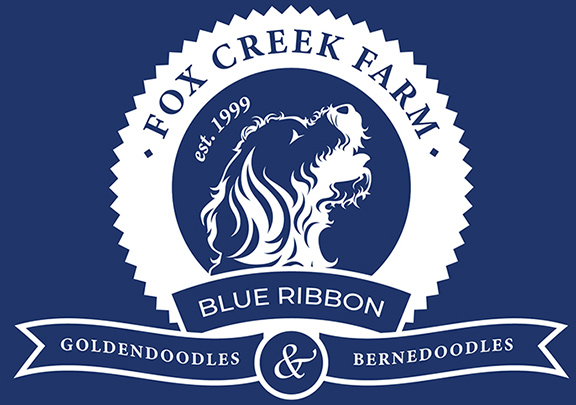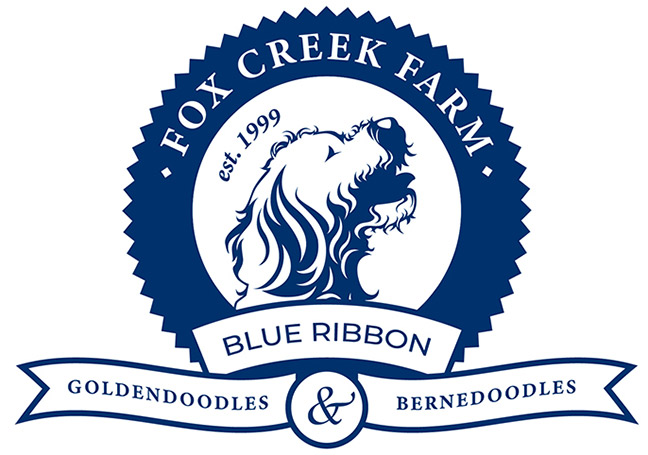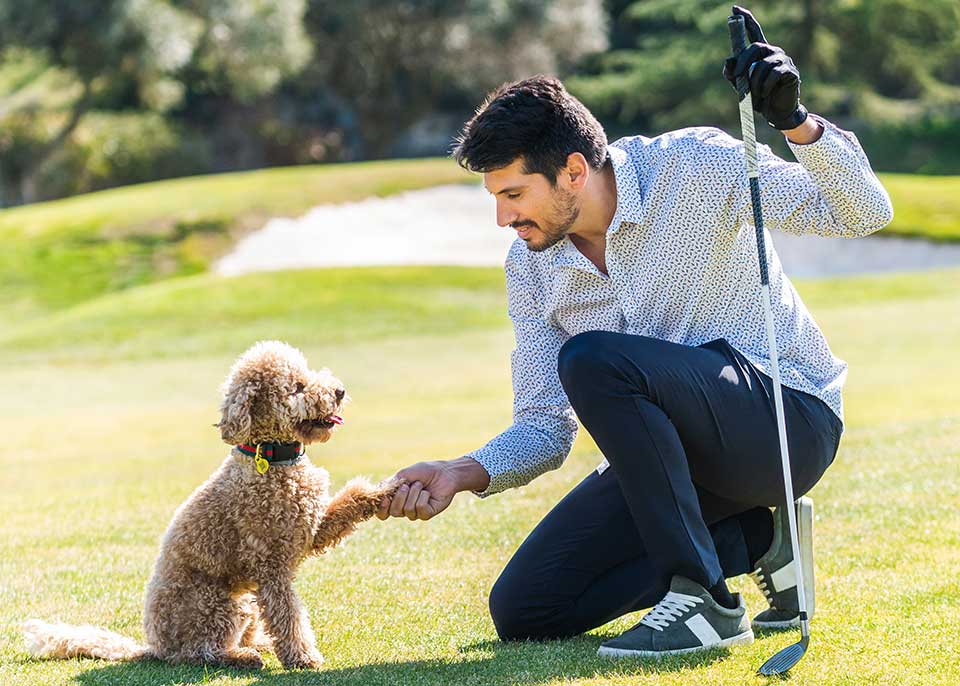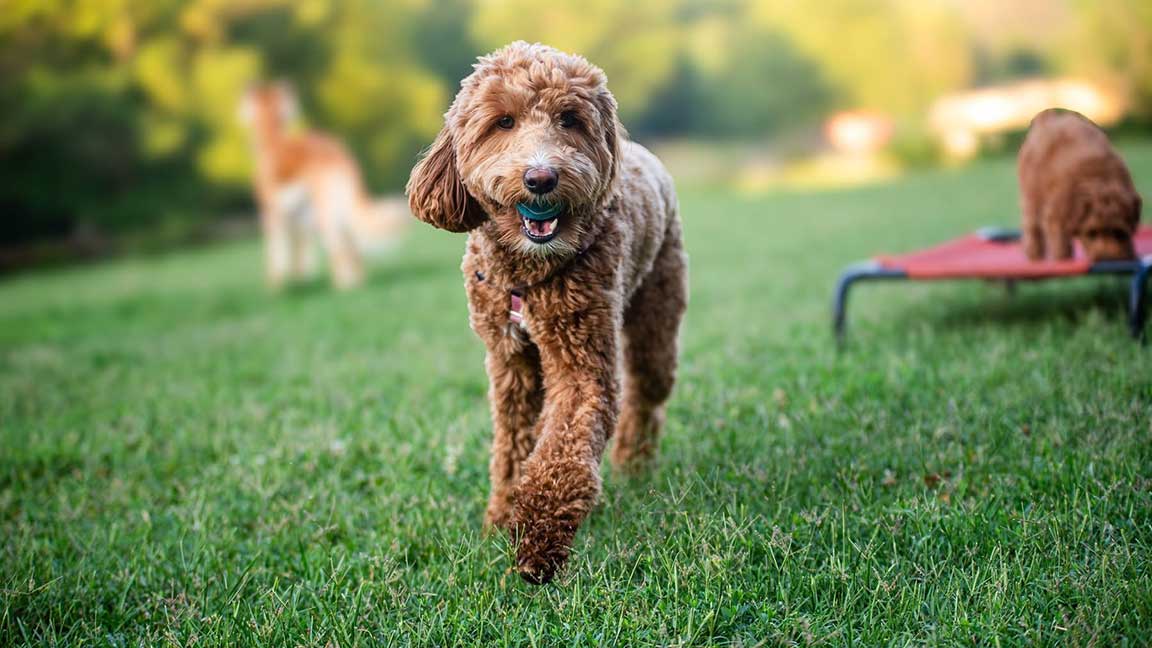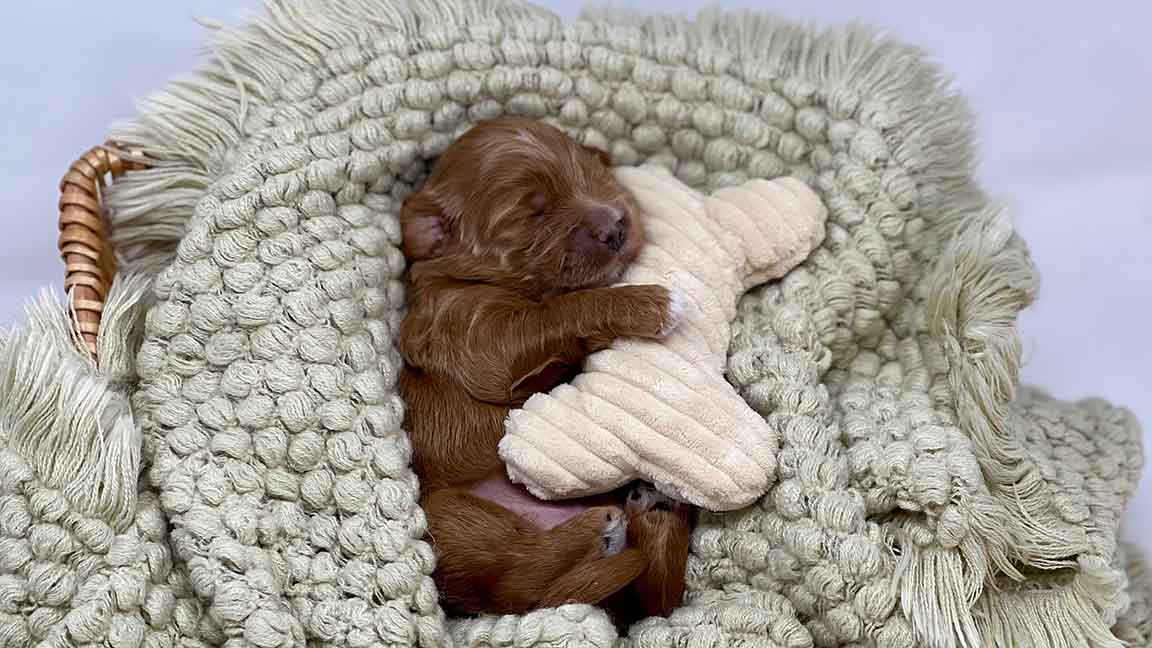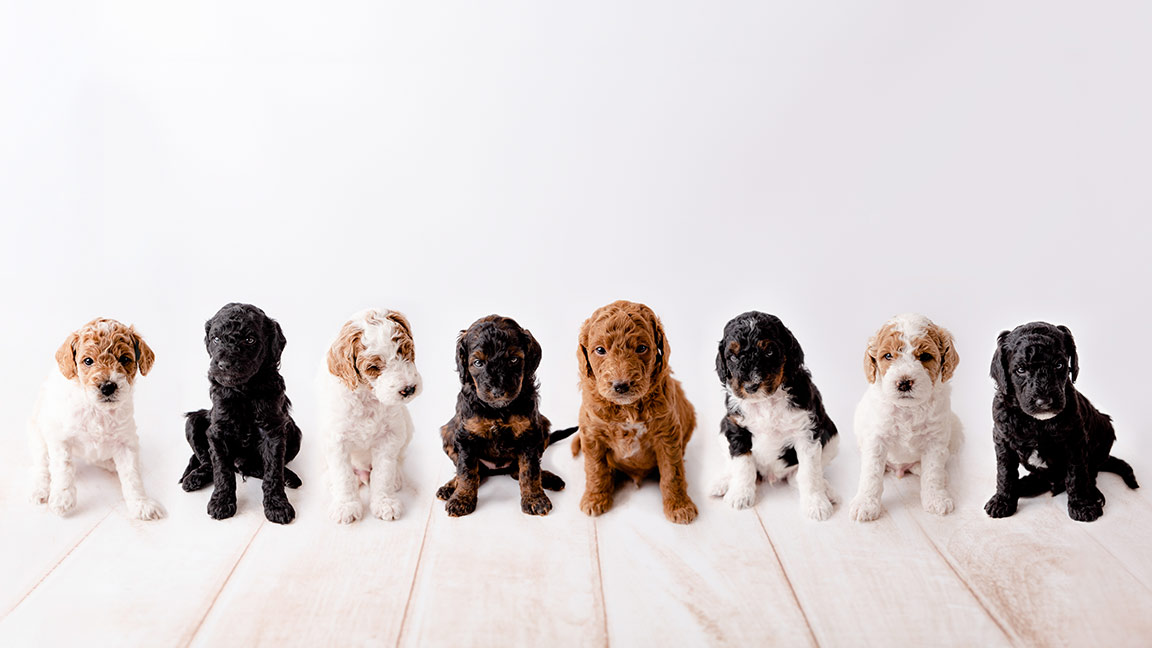
Should I Get a Male or Female Goldendoodle Puppy?
When it comes to getting a new dog, one of the most common questions people ask is, “Should I get a male or female?” Various factors, including personal preference, breed, temperament, and physical attributes, may influence your decision. In this blog post, we’ll focus on Goldendoodles – a delightful hybrid mix of Golden Retriever and Poodle –and we’ll delve into the differences between males and females, covering everything from training to size to health conditions.
Physical Differences: The Male Doodle vs. The Female Doodle
Suppose we’re talking specifically about a mini Goldendoodle, which averages around 30 pounds. In that case, there are some physical differences you should consider. Male dogs, specifically male Goldendoodles, tend to be taller and heavier than female dogs. This is due to genetic factors and reproductive hormones. However, the disparity in size might not be as noticeable in a Goldendoodle as in some other breeds due to their mixed genetics.
Size and Weight
Male Goldendoodles are often larger than their female littermates in terms of height and weight. They have a sturdier build, with a typical adult male mini Goldendoodle standing between 15 to 17 inches tall at the shoulder and weighing between 30 to 35 pounds, depending on the parents’ size.
Female Goldendoodles from the same litter, in comparison, are usually a bit smaller, with an average height of 14 to 16 inches at the shoulder and an average weight range between 26 to 30 pounds. Again, this can vary based on the parents’ size. Note that male and female Goldendoodles can fall between the designated height of 14-17 inches and 26-35 pounds. For ease of comparison, we are describing averages within a single litter.
Coat and Appearance
Both male and female Goldendoodles can have a straight, wavy, or curly coat. Their coat is known for being low to non-shedding, which makes Goldendoodles a popular choice among people with allergies. However, coat texture, color, and length can vary between individual dogs and are not influenced by gender.
Musculature and Build
Male Goldendoodles typically have a more robust build, with a broader chest and larger muscles. This isn’t to say that female Goldendoodles aren’t strong – they certainly are – but males tend to have a slightly more muscular physique due to their testosterone levels. This is most noticeable in the standard Goldendoodle versus the mini Goldendoodle. However, it is always possible to have a male exhibit a less robust structure if it inherits more of the Poodle physique, just as a female could have a sturdier build if taking after the Golden Retriever genes in her lineage.
Training and Behavior: Are Male or Female Dogs Easier to Train?
There are multiple myths saying one gender or the other is easier to train, and obviously, both can’t be true. In reality, it comes down to the individual dog’s breed, temperament, and training methods rather than their gender. Both intact males and females can have unique gender traits, but after being desexed (spayed or neutered), most dogs tend to have a more nonbinary presence. However, it’s common for male and female Goldendoodles to be intelligent and eager to please, making them generally easy to train.
But remember, the teenage phase is a challenging period for all dogs. Patience, consistency, and positive reinforcement are key to managing this stage.
Trainability: Is There a Difference?
Trainability depends more on individual temperament, breed, and upbringing than gender. Goldendoodles, irrespective of their gender, are renowned for their love of learning and performing, traits inherited from their Poodle and Golden Retriever lineage. These qualities make them relatively easy to train.
Understanding Male Behavior and Training
Male Goldendoodles, especially if they are unneutered, can sometimes display territorial behaviors like marking. They can also be more easily distracted during training, mainly when other dogs or interesting smells are around. However, males are often very eager to please their owners, which can be a positive trait when it comes to training. They might require consistent reinforcement of training rules, especially during their ‘teenage’ phase when they’re full of energy and curious about the world.
Understanding Female Behavior and Training
Female Goldendoodles are often described as more independent and more consistent in their behavior. Some trainers find females easier to work with because they tend to be less easily distracted and more focused. However, this is not a hard-and-fast rule. Like males, female Goldendoodles can also go through a ‘teenage’ phase where their behavior can be more unpredictable.
Training Techniques: What Works Best?
Regardless of the gender of your Goldendoodle, positive reinforcement is the best approach to training. This method involves rewarding your dog for desired behavior, which encourages them to repeat it. The reward can be a tasty treat, verbal praise, or a fun game. Remember, consistency and patience are key. Both male and female Goldendoodles will benefit from clear, consistent commands and training routines.
Health Considerations: Males or Females?
You might also wonder about health conditions. Both male and female Goldendoodles can be prone to certain breed-specific health problems due to their Golden Retriever and Poodle heritage. It is important to understand the presence of reproductive organs in unneutered and unspayed dogs may also lead to gender-specific health issues. It’s essential to choose a reputable breeder who prioritizes the health of their pups and completes health screening and certifications on all their breeding dogs to decrease or avoid occurrences of health issues in the puppies they create.
Health in Male Goldendoodles
If not neutered, male dogs can be prone to specific health issues associated with the male reproductive system. These might include testicular cancer and specific prostate problems. An unneutered male can also exhibit behavior problems related to hormones, like aggression or marking, which isn’t directly a health issue but can be a concern for pet owners.
Health in Female Goldendoodles
Unspayed female dogs may be at risk for conditions such as pyometra, a severe, potentially life-threatening uterus infection, and mammary tumors. If not spayed, female dogs also go into heat typically twice a year, which can result in messiness and attract male dogs. An unspayed female who is in heat must be kept inside or under the direct control of a human while outside, as she can be detected by an intact male up to two miles away. An unplanned litter of puppies can easily be the result of irresponsible breeding.
Neutering/Spaying and Health
Neutering (for males) and spaying (for females) can mitigate some of the gender-specific health risks mentioned above. These procedures involve the removal of reproductive organs, which means the dogs can’t reproduce, but also can’t develop reproductive organ-specific diseases like uterine, ovarian, or testicular cancers. However, these procedures are not without controversy, as some studies suggest they increase the risk of certain other health conditions and could affect a dog’s growth if done too early. Discussing the timing and pros and cons of these procedures with a trusted veterinarian is best. Understanding any contractual agreements with your breeder covering the age of desexing is an important consideration when choosing a breeder.
 Breed-Specific Health Testing
Breed-Specific Health Testing
Good breeders should test their breeding dogs for breed-specific genetic diseases as well as physical deficiencies, which in Goldendoodles includes hip, elbow, and patella testing and ophthalmologist and cardiology evaluations. Ensuring your puppy comes from health-tested parents can significantly decrease the risk of inheriting certain genetic diseases.
Characteristics and Temperaments: Male Dogs vs. Female Dogs
Another aspect to consider while choosing between a male and a female Goldendoodle is their temperament. While it is important to remember that each dog, irrespective of their gender, will have a unique personality, there are some general characteristics often associated with male and female dogs.
Regarding social behavior, male dogs, including the male Goldendoodle, may display dominance or territorial behaviors once they’ve reached sexual maturity. This behavior could become a problem if not managed correctly, mainly if there are other intact male dogs in the house. Female dogs at sexual maturity may exhibit more independence, which can sometimes be mistaken as aloofness. They might be less interested in play and more focused on their environment. Intact females can have hormonal fluctuations, which sometimes cause incompatibility between two females.
Male Dogs: Characteristics and Temperament
Male dogs are typically more outgoing and playful and tend to love family members equally. They are often described as more affectionate and more eager for human attention. They are often willing to leave their task for a bit of extra fuss from their human companions. They also can be more territorial and may display dominant behavior, especially around other male dogs, but this can easily be mitigated by neutering.
In terms of training, intact male dogs can sometimes be more easily distracted, especially in the presence of other dogs, with intriguing smells, or in a new environment. Despite this, their playful and attention-seeking nature can make them fun to train. However, the testosterone responsible for distracting a male dog is not an issue until sexual maturity, which occurs sometime between 8 and 12 months of age. Up until that point, there should be no noticeable difference in how males and females deal with distractions.
Female Dogs: Characteristics and Temperament
Female dogs are often described as more independent and a bit more reserved or aloof than males. They can be equally affectionate, but they usually prefer to seek out attention on their terms. Some dog owners describe their female dogs as seeming more ‘serious’ or ‘dignified,’ even from a young age. It is common for females to bond with a specific family member heavily.
Female dogs are generally less likely to engage in dominance or territorial behaviors than males unless they have a litter of puppies to protect. However, females that are in heat can suffer from hormonal fluctuations that can cause unpredictable behavior towards other dogs.
Practical Considerations: The Right Match for Your Lifestyle
No matter how cute a Goldendoodle puppy is, or whether it’s a male or female, it’s crucial to ensure they fit well within your lifestyle. The gender differences described above are common in dogs that are not spayed or neutered. When a male or a female dog is desexed, their reproductive capabilities are removed, including the hormones that cause differences in specific gender traits. It becomes difficult at that point to determine any differences in temperaments, intelligence, or activity levels.
Size and Space
Male dogs, being generally larger, might require more space to move around comfortably, particularly in the case of larger breeds. A female dog might be a more practical choice if you’re living in a small apartment. However, since Goldendoodles come in many sizes, it is easy to choose a Goldendoodle that will mature to an appropriate size to fit your home.
Activity Levels
While activity levels can vary more by breed and size than by gender, it is important to realize all dogs need exercise. A larger dog could be a great companion for hiking, running, or other activities if you lead a very active lifestyle. On the other hand, if you’re looking for a less active companion, a smaller dog might be a better match, as it can utilize a smaller space to expel energy while running and playing.
Training and Behavioral Issues
Male dogs will be more likely to engage in behaviors like marking if not neutered before sexual maturity. This involves lifting a hind leg to urinate in multiple locations to claim territory. This activity can be completely avoided by neutering. A challenge in training females that are not yet spayed can include being housebound for approximately 21 days at a time while they are in heat. It is important to keep them secluded and out of access to all unneutered male dogs during this time. It is not uncommon to have intact male suitors who have jumped their fence frequenting your property in hopes the cycling female will come out to play.
Health and Care
Male dogs may be more prone to certain health conditions and females to others. Regular vet check-ups are crucial for either gender to monitor for any potential health issues. Also, remember to consider the costs and implications of spaying/neutering if that’s something you’re planning to do. If you purchased your Goldendoodle from a responsible breeder, no doubt you are required by contract to spay/neuter by a certain age. Spaying/neutering all dogs that are not specifically designated as breeding dogs is considered to be responsible pet ownership.
Social Dynamics
Consider the social dynamics if you already have other pets. Male and female dogs can get along with other dogs, but introductions should be done carefully to ensure harmony. Two unneutered males, for instance, might be more likely to clash than two unspayed females.
The Golden Question: Male Doodle or Female Doodle?
Choosing between a male or female dog is a personal decision that depends on numerous factors. The most important factor to consider is the gender of any existing dogs already in the home. A desexed male and female pairing is typically the best for compatibility. It is a devastating situation to learn you acquired a companion for your existing dog that creates chaos in the home. Instead of choosing a gender for yourself, concentrate on choosing the best partner for your dog. You should have multiple playdates with other dogs coming to your home to see if your dog has a gender preference. Playdates should always begin with both dogs being on short leashes for introductions. Off-leash play should only be allowed when both dogs have displayed friendly demeanor, including wagging tails. Playtime should be closely monitored, and mental notes should be taken on the level of enjoyment experienced by your dog. If you see your dog enjoys the interaction with a specific gender, then that is the gender you should choose when adding a second dog. Remember that you need to allow your dog to experience playdates with multiple dogs one at a time. The level of enjoyment with a particular dog may not be due to its gender but, instead, its personality or size.
Conclusion
If it will be the first dog in your home, then the gender becomes much less important. As mentioned above, responsible pet ownership involves spaying or neutering your family pet. This creates a gender-neutral dog making gender selection unimportant.
When considering a specific breed, like the Goldendoodle, it’s crucial to bear in mind their common health conditions, their known trainability, and the breed’s overall temperament. Regardless of gender, Goldendoodles are known for their intelligence, friendliness, and low-shedding coats, making them an excellent choice for many families.
One crucial thing to remember is that while we’ve discussed general tendencies, every dog is an individual. You might find a super playful female or a very calm and independent male dog. The dog’s upbringing, training, and individual personality can often outweigh the impact of their gender on their behavior and temperament.
The most important thing is to choose a dog that fits well with your lifestyle and to provide them with the love, care, and training they need to be a happy, well-behaved companion. Whether you fall in love with a male or a female dog, Goldendoodle, Golden Retriever, or any other breed, the bond you’ll develop with your furry friend will be exceptional.
In the end, while it’s interesting to consider the differences between male and female dogs, the most fulfilling part of bringing a new dog into your home will be the unique personality traits and quirky habits that will make your dog truly one of a kind. Here’s to finding your perfect canine companion!
